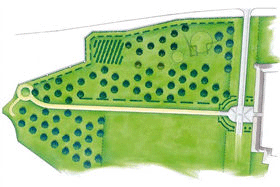The Fruiticum

The abbeys of the Cistercian Order, branch issued from the Benedictine trunk in the 12th century, have always owned a 'farm', aiming to put into practice and live the true essence of Saint Benedict's Rules; 'ORA ET LABORA' : pray and work (notably with your hands).
Charlemagne also commanded, in his 'Capitulare de Villis', to cultivate in all imperial 'villae' a big quantity of various plants. The first two of the list being the lis and rose (probably the Rosa gallica). The same list ending by the different fruit species.
After Charlemagne died, all these recommendations were unfortunately forgotten by everyone but the monks. In their huge gardens, they kept on collecting the
species and varieties that had always been grown and added the new ones they were given or discovered by themselves in nature. Some varieties were named
after the abbeys that found them : the Val Dieu pippin, for example. (A. Leroy - Dictionnaire de Pomologie)
That is what we are attempting to do here at the Farm of the Abbey of La Ramée.
Our Fruiticum is planted at the same place the Cistercian monks grew their own. The location is excellent, gently sloping to the south, a soil particularly favorable to the cultivation o cereals, beets and fruit trees.
In the 19th century, Belgium abounded in orchards of a tremendous richness of varieties. Our country became worldwide famous by imroving the range of the varieties of pears : about 1,100 new varieties were gained by seedling (up to 200 for the district of Jodoigne only).
Each abbey also owned a small vineyard until 19th century.
Since 1950, the standardization and rationalization inherent in an intensive trading production lowered and keep on hugely reducing the range of the cultivated varieties.
The Fruiticum aims to :
- gather some 350 old endangered varieties inorder to safeguard them
- integrate recent varieties that could be cultivated with profit in the private gardens of our humid temperate area
- exalt the beuty of 'standard trees' orchards (unfortunately endangered) and arouse the interest for beautiful fenced shapes in confined spaces
- show the extraordinary range of shapes, colours, fragrances and flavours of all those varieties
- teach happy owners of private gardens the art of good planting, cutting back, creating, grafting and looking after fruit trees by the most natural means
- observe the behaviour of some cultivated varieties in unusual conditions, particularly by fenced shapes
The inauguration of the fruiticum started with the planting on 25th November 2000 (Saint Catherine's day).
Almost all the fruit species are present : pears, apples, cherries, peaches, apricots, big fruit brambles (Rubus), bilberries and even vines. It is made of an international collection of varieties from Belgium, France, Great Britain, Germany, the Nederlands, Denmark, Switzerland, Russia, Canada, the USA, Japan, ...
Five years have already passed...
- most of the cultivated varieties in fenced shapes already produce fruit. Some standard trees also started bearing fruit.
- we planted some grafted pear and apple trees in order to graft other varieties. The collection is becoming richer from year to year.
- we also created an osier plantation in order to provide straps for the fencing of branches. It is made of osier varieties from Lesdain (the biggest center of Walloon breeding grounds) and from the French National School of basketry and osier breeding in Fayt-Billot.
- jams are being home made from small fruit from the Fruiticum.
Tomorrow :
This noble task must be carried on in order to
1. increase the biodiversity in family orchards
2. find again and save many other good old varieties
3. take part in the education of amateurs with the help of didactic sheets, websites and classes on the location
J.P. WESEL